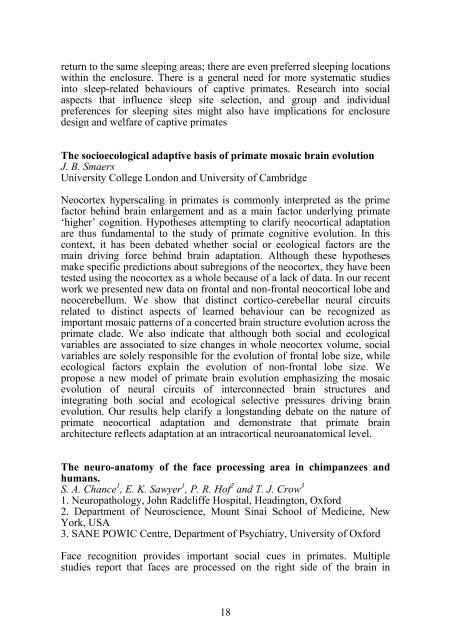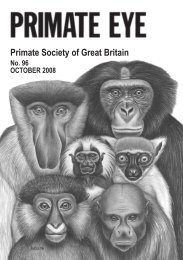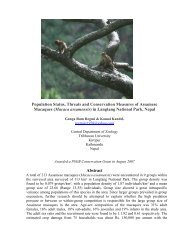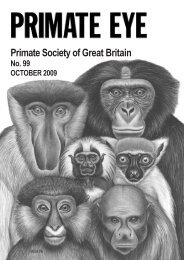2010 Vol 101.pdf (1.63mb) - Primate Society of Great Britain
2010 Vol 101.pdf (1.63mb) - Primate Society of Great Britain
2010 Vol 101.pdf (1.63mb) - Primate Society of Great Britain
You also want an ePaper? Increase the reach of your titles
YUMPU automatically turns print PDFs into web optimized ePapers that Google loves.
eturn to the same sleeping areas; there are even preferred sleeping locations<br />
within the enclosure. There is a general need for more systematic studies<br />
into sleep-related behaviours <strong>of</strong> captive primates. Research into social<br />
aspects that influence sleep site selection, and group and individual<br />
preferences for sleeping sites might also have implications for enclosure<br />
design and welfare <strong>of</strong> captive primates<br />
The socioecological adaptive basis <strong>of</strong> primate mosaic brain evolution<br />
J. B. Smaers<br />
University College London and University <strong>of</strong> Cambridge<br />
Neocortex hyperscaling in primates is commonly interpreted as the prime<br />
factor behind brain enlargement and as a main factor underlying primate<br />
‘higher’ cognition. Hypotheses attempting to clarify neocortical adaptation<br />
are thus fundamental to the study <strong>of</strong> primate cognitive evolution. In this<br />
context, it has been debated whether social or ecological factors are the<br />
main driving force behind brain adaptation. Although these hypotheses<br />
make specific predictions about subregions <strong>of</strong> the neocortex, they have been<br />
tested using the neocortex as a whole because <strong>of</strong> a lack <strong>of</strong> data. In our recent<br />
work we presented new data on frontal and non-frontal neocortical lobe and<br />
neocerebellum. We show that distinct cortico-cerebellar neural circuits<br />
related to distinct aspects <strong>of</strong> learned behaviour can be recognized as<br />
important mosaic patterns <strong>of</strong> a concerted brain structure evolution across the<br />
primate clade. We also indicate that although both social and ecological<br />
variables are associated to size changes in whole neocortex volume, social<br />
variables are solely responsible for the evolution <strong>of</strong> frontal lobe size, while<br />
ecological factors explain the evolution <strong>of</strong> non-frontal lobe size. We<br />
propose a new model <strong>of</strong> primate brain evolution emphasizing the mosaic<br />
evolution <strong>of</strong> neural circuits <strong>of</strong> interconnected brain structures and<br />
integrating both social and ecological selective pressures driving brain<br />
evolution. Our results help clarify a longstanding debate on the nature <strong>of</strong><br />
primate neocortical adaptation and demonstrate that primate brain<br />
architecture reflects adaptation at an intracortical neuroanatomical level.<br />
The neuro-anatomy <strong>of</strong> the face processing area in chimpanzees and<br />
humans.<br />
S. A. Chance 1 , E. K. Sawyer 1 , P. R. H<strong>of</strong> 2 and T. J. Crow 3<br />
1. Neuropathology, John Radcliffe Hospital, Headington, Oxford<br />
2. Department <strong>of</strong> Neuroscience, Mount Sinai School <strong>of</strong> Medicine, New<br />
York, USA<br />
3. SANE POWIC Centre, Department <strong>of</strong> Psychiatry, University <strong>of</strong> Oxford<br />
Face recognition provides important social cues in primates. Multiple<br />
studies report that faces are processed on the right side <strong>of</strong> the brain in<br />
18






